080817_YKBP_A7.pdf






Broadcaster Press 7
August 8, 2017 www.broadcasteronline.com
STUDENTS,
Welcome
Back
Navigating Tech Choices
For School Use
Technology is essential in the daily lives
of students. Whether it’s kids learning their
ABC’s or graduate students pursuing advanced degrees, technology has transformed
the way lessons are taught and learned.
Statistics support the notion that technology in the classroom is irreplaceable.
According to data from the tutoring resource
PracTutor, Houghton Mifflin Harcourt and
various colleges, 98 percent of schools have
one or more computers in the classroom.
In addition, 77 percent of teachers use the
internet for instruction, while 40 percent of
teachers report students use computers during instructional time in the classroom.
Many instructors now assign homework
that must be completed online. The Organization for Economic Cooperation and Development looked at computer usage among
15-year-olds across 31 nations and regions.
Many students in high-performing nations
reported spending between one and two
hours a day on a computer outside of school.
Because computers are so necessary in and
out of the classroom, families and students
may want to revisit their options before buying new devices.
Desktop Computer
Desktop computers used to be the go-to
for families and students, and there are still
many reasons why desktops make sense. In
addition to their relatively inexpensive sticker
price, desktop computers allow students to
customize their packages according to their
needs and get a powerful operating system
in the process. New and advanced processing speeds also mean that many desktop
computers can be relied on for educational
purposes while also being fast enough to
handle recreational gaming.
One of the main disadvantages of desktop
computers is their lack of portability. Desktops are not easily moved, and if repairs are
necessary, it can be a hassle to have them
fixed.
Laptop Computers
Over the last decade, laptop computers
have become more popular than desktop
computers, largely because of their portability. Laptops are designed to be taken from
place to place, so students can use them for
note-taking in the classroom and then studying at home.
Although laptop processors have just
about caught up to desktop processors,
they may be lacking the processing pop
unless consumers are willing to pay more
for laptops with high performance. Another
shortcoming of laptops is that they generally
have smaller screens than desktop computers, which can make working on fine details
more challenging.
Tablets
Tablets offer the most in terms of portability. They’re lightweight and small and offer
a wealth of access in a compact package.
Today’s tablets offer much more than the first
such devices to hit the market. Some can run
apps and equivalent programs that were once
exclusive to desktop and laptop computers.
Tablets also tend to be less expensive than
desktops or laptops.
Where tablets may fall short is in the
peripherals. It’s difficult to connect backup
drives and other accessories to tablets.
However, with advancements in cloud-based
storage, this may not be an issue. Also, notetaking on virtual keyboards may be more
challenging, and working on tablets’ small
screens can be tiresome over time. Convertible tablet/laptops are now emerging to bridge
these gaps.
Shopping for a new computer can be
complicated, but basing purchases on need
rather than want can help guide the process.
Finding Balance With
Extracurricular Activities
Many high schools, colleges and universities emphasize their goals of producing wellrounded students. Extracurricular activities
teach students important life lessons, provide
them opportunities to socialize and often
stimulate their minds and bodies in ways that
differ from the stimulation provided in the
classroom.
Data from the U.S. Census Bureau states
that, in 2014, 57 percent of children between
the ages of 6 and 17 participate in at least one
after-school extracurricular activity. Children
are more likely to participate in sports than
clubs or lessons, such as music, dance and
language, but each of these activities can be
beneficial to students’ development.
Students who participate in extracurricular activities may want to limit their
participation to 20 hours per week. This is
according to a group of professors from Stanford University and Villanova University who
have been collecting data on the issue since
2007. In their report “Extracurricular Activity
in High-Performing School Contexts: Stress
Buster, Booster or Buffer?”, Jerusha Conner
and Sarah Miles found that 87 percent of kids
who would be considered to have packed
schedules were perfectly happy unless they
were doing more than four hours a day.
The “over-scheduling hypothesis” may
be overhyped. This is the concern that too
much organized activity participation leads to
poor developmental outcomes. This hypoth-
esis also suggests that hectic schedules also
undermine family functioning, detract from
schoolwork and possibly increase the risk of
copycat behaviors and excessive competitiveness. However, in the study “The OverScheduling Hypothesis Revisited: Intensity
of Organized Activity Participation During
Adolescence and Young Adult Outcomes,”
researchers J.L. Mahoney and Andrea Vest
determined that, controlling for demographic
factors and baseline adjustment, extracurricular intensity was a significant predictor of
positive outcomes and unrelated to indicators
of problematic adjustment (e.g., psychological
distress, substance use, antisocial behavior)
at young adulthood.
Even though extracurricular activities are
largely positive - even when schedules are
packed - parents need to be aware of the diminishing returns of too many activities. This
is something called the “threshold effect.”
Benefits from extracurriculars can level off
when too many activities are being juggled. If
a child is experiencing anxiety, sleeplessness
or depression, or seems overly stressed, it
could be time to reduce students’ time spent
doing structured activities.
It’s essential that families use the cues
given by kids to assess what students can
handle. And children should be encouraged
to be honest with their parents about their
extracurricular activities as well.
Fall Registration
Preschool through 5th grade is on
Wednesday, August 16th
4:30 - 7:00 p.m.
General Assembly at 5:30 p.m.
Did you know?
Modern technology has forever transformed the classroom. As calculators
replaced abacuses, mobile phone apps have
now replaced calculators, and such advancements continue to change how students
learn. One way schools are notably different
from those of the past is through the absence
of a once major component of the classroom
layout. Chalkboards are either missing or
completely retrofitted in modern learning
environments. In the 1800s, slate blackboards
were the new technology, replacing handheld
tablets of wood or slate. Within the last few
years, schools have increasingly opted for
cleaner “white boards” or “smartboards,”
which are digitally connected to computers
and offer touch interfaces similar to those on
tablets and smartphones. As ebooks replace
textbooks and more assignments are handed
in via digital documents, lockers may be the
next to vanish.
Registration will take place in the classrooms
& new addition. Please come, even if you are
pre-registered. Call if you are unable to attend.
Classes Begin:
Wednesday August 23rd, 2017
at 8:20 a.m.
Contact: St. Agnes School, 909 Lewis Street, Vermillion, SD 57069 • 605.624.4144
Wake up
with
Corner of W. Cherry & Stanford
605-624-8050
Convenience at your back door - 24/7
Hot Coffee • Hot Chocolate • Lattee’s
• Juice • Pop • Breakfast Pizza
• Breakfast Sandwiches • other great Breakfast snacks
Or try one of our energy drinks morning, noon or afternoon to keep you going
in Vermillion
Serving Clay, Union, Turner Counties in South Dakota
(605) 624-5311
Hands are not
for hitting and
words were not
meant to be cruel


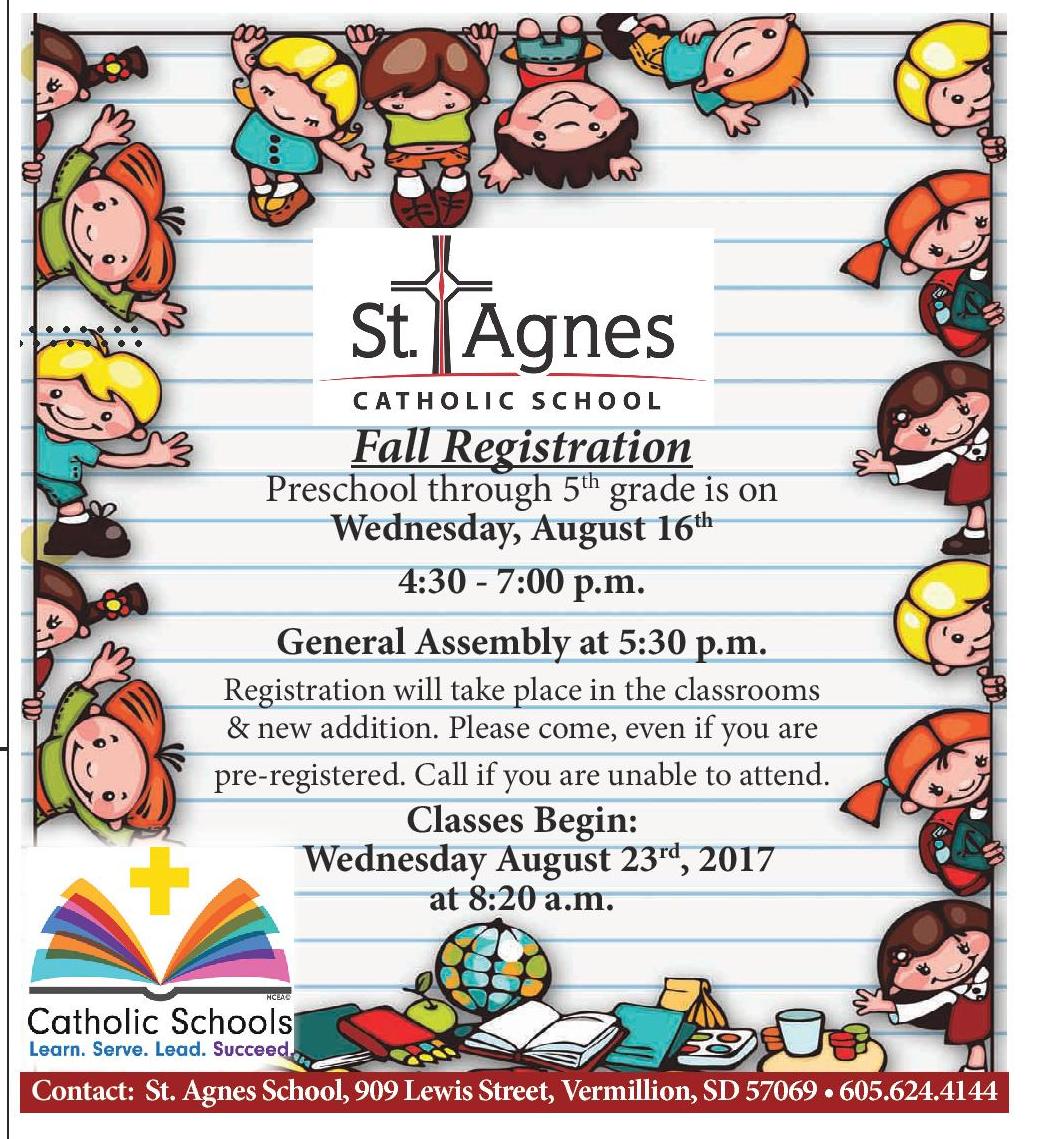





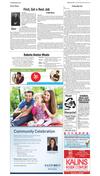



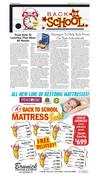
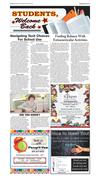
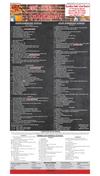
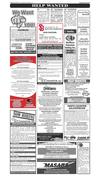


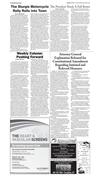
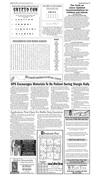

 Previous Page
Previous Page






